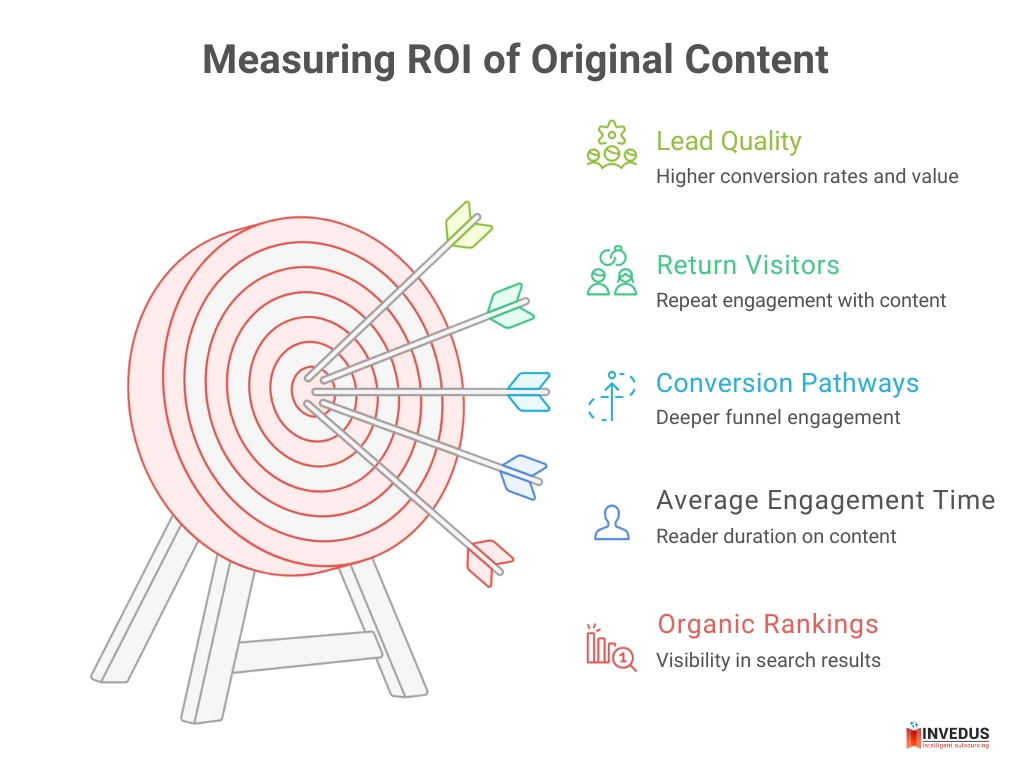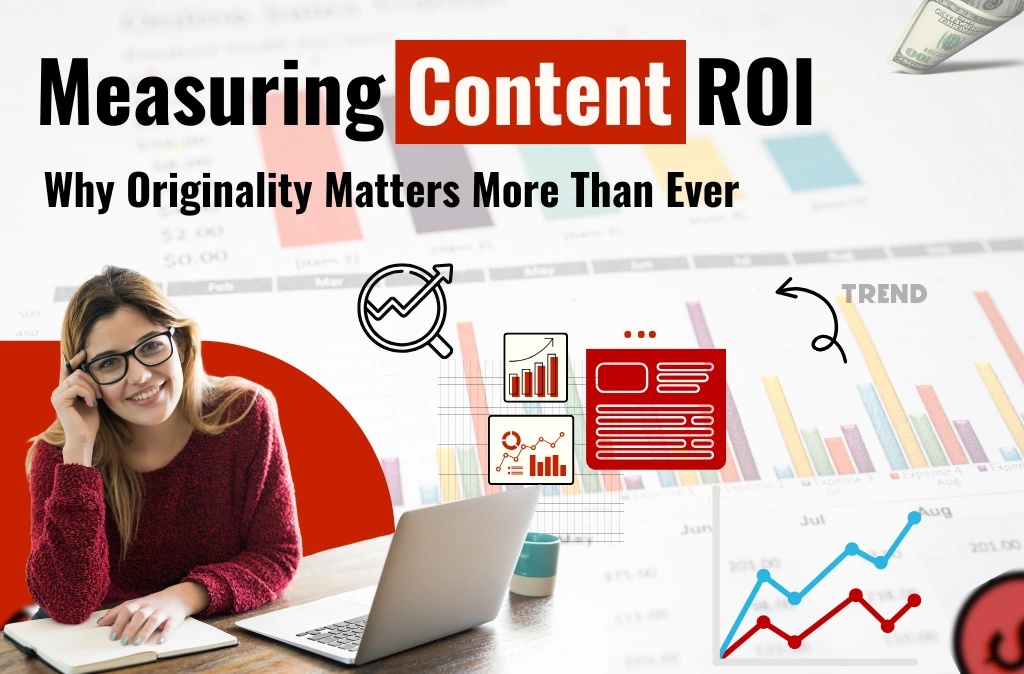Every business invests in content, but very few know the exact value they’re getting back. Marketers push out blogs, videos, whitepapers, and campaigns without always tying them to tangible results. That’s where ROI comes in.
But here’s the catch: numbers alone don’t tell the whole story. Sometimes, engagement and other numbers are good, but you don’t get what you want. It generally happens when you post duplicate or stolen content.
Search engines punish duplication, and audiences tune out recycled ideas. No matter which business domain you are in, originality always matters. It separates content that quietly disappears from content that delivers measurable growth. Without it, ROI collapses before the first click.
Why Content ROI Needs a Different Lens?
ROI in content marketing goes beyond traffic and clicks. Sure, pageviews matter. Conversions matter even more. But how content earns those numbers makes all the difference. You can drive thousands of visitors with copied or rehashed material, yet conversions remain flat. Why? Because duplicated insights don’t build trust.
Content ROI should measure three things:
- How effectively it builds brand authority
- How much does it contribute to conversions over time
- How it strengthens customer trust and loyalty
Numbers without context hide the real story. Authentic content attracts attention and keeps people coming back. That’s where originality creates compounding value.
Originality as the Foundation of ROI
Search engines reward unique perspectives. Google’s algorithm doesn’t just analyze keywords; it examines depth, structure, and whether content adds something new. Copycat articles rarely climb the rankings, no matter how optimized they look.
For readers, originality is even more crucial. Audiences are savvy. They can detect when content is rephrased or recycled from competitors. Once they spot it, credibility takes a hit. And if trust fades, ROI falls apart.
Originality impacts ROI in four main areas:
- Visibility: Unique insights improve search rankings and exposure.
- Engagement: Readers share and comment on fresh perspectives, not rehashed guides.
- Retention: A brand remembered for new ideas wins long-term followers.
- Conversion: Customers act when they trust your voice as authentic.
Measuring ROI the Wrong Way
Too many marketing teams stop at surface numbers when judging success. They highlight a spike in impressions or cheer about thousands of clicks without asking the harder question: did those visitors take meaningful action?
A blog can attract heavy traffic through a catchy headline, but if readers leave after a few seconds, it delivers nothing. Weak engagement, low conversions, and short attention spans are clear signs that the content failed to provide genuine value. And lack of originality is often the reason behind that.
Measuring ROI the Right Way

To connect originality with ROI, measurement needs to go deeper. Metrics must show how unique content performs differently from generic pieces.
Key areas to track:
- Organic Rankings: Are your original articles ranking higher and longer?
- Average Engagement Time: Do readers stay longer on unique content?
- Conversion Pathways: Does original content lead visitors deeper into your funnel?
- Return Visitors: Are people coming back for more of your perspective?
- Lead quality: Do prospects from original content convert faster or at a higher value?
This type of measurement highlights how originality drives sustainable results.
The Cost of Unoriginal Content
That’s why smart marketers rely on an AI detector, it catches unoriginal or automated writing before it slips through, helping brands stay genuine and ahead of the curve.
The consequences of stolen content include:
- Lower rankings due to duplicate signals
- Declining trust from audiences who notice repetition
- Missed opportunities to stand out in saturated niches
- Reduced long-term traffic growth
- Higher costs of customer acquisition because weak content fails to persuade
Every unoriginal article carries hidden costs that stack up over time.
Why Search Engines Care About Originality
Search engines survive on user satisfaction. If searchers consistently land on repetitive, shallow content, they switch platforms. To prevent that, Google trains algorithms to detect originality signals.
These signals include:
- Use of original research or case studies
- Unique structuring of ideas rather than common templates
- Fresh data, statistics, and examples not found elsewhere
- Distinctive tone and voice
In short, originality aligns your brand with Google’s goals: providing the best answers possible. Without it, content struggles for visibility, and ROI flatlines.
How to Build Originality Into Your Content Process
Audit Regularly
Don’t just check for broken links. Look at whether your content repeats the same angles everyone else uses. Regular reviews help spot gaps, find new ideas worth covering, and keep your content fresh instead of blending into identical material already online.
Involve Subject-Matter Experts
Writers can explain ideas, but experts bring authority. Their real examples and insights turn ordinary content into something credible. Involving them means readers see depth, not surface-level commentary. That trust builds authority and makes your content perform better over time.
Prioritize Original Data
Original data always carries weight. Surveys, customer insights, or internal numbers give content something competitors can’t copy. Moreover, readers respect content backed by real evidence, and search engines reward it. Over time, this type of work becomes a reference others cite, extending reach and ROI.
Develop a Unique Voice
A brand voice matters as much as the information itself. Consistent style makes content recognizable and memorable. Readers connect with personality, not generic wording. A distinct voice keeps them coming back, builds loyalty, and strengthens engagement that directly improves long-term returns.
Update and Expand
Old content loses impact if ignored. Whereas, refreshing articles with new stats or expanding them with richer examples keeps them relevant. Additionally, turning short pieces into guides or adding case studies extends their value. In short, updates extend shelf life and improve ROI without starting from scratch.
Check Plagiarism
Even small overlaps with existing material can damage rankings. Before publishing, always detect potential plagiarism to ensure your content remains original and trustworthy. It protects originality, prevents penalties, and reassures readers that your work is authentic. This step safeguards both credibility and performance in the long run.
Also read: Advanced Content Marketing Tips To Maximize The ROI and Essential Tools Every Content Writer Should Use
Conclusion
Measuring content ROI without considering originality misses the bigger picture. Numbers like clicks and impressions are surface-level indicators. The true drivers of ROI are authority, trust, engagement, and conversions. And all of them depend on originality.
Unique insights fuel visibility, capture attention, and create compounding long-term value. Brands that prioritize originality see stronger returns not only today but years from now. Those that recycle ideas fall behind, trapped in short-term spikes that never turn into real growth. Hence, originality isn’t optional anymore. It’s the foundation of ROI.







